 |
JAPANESE PRINTS
A MILLION QUESTIONS
TWO MILLION MYSTERIES
Ukiyo-e Prints浮世絵版画 |
|
Kansas City, Missouri |
|
UTAGAWA HIROSADA 歌川広貞 (fl. 1819-65) |
||
|
Actor: Kataoka Gadō 片岡我童 |
||
|
Role: Ashikaga Yorikane 足利頼兼 |
||
|
Play: Meiboku Sendai Hagi (?) (Kataoka Gadō is known to have performed the role of Ashikaga Yorikane at the Chikugo no Shibai in Osaka in the third month of 1848.) 伽羅先代萩 |
||
|
Date: 3rd Month, 1848 Kaei 1 嘉永1 |
||
|
Print Size: 10" x 7 1/8" |
||
|
Mat Size: 20" x 16" |
||
|
Publisher: Kawaoto 川音 |
||
|
|
Condition: Good color, brown stain on embossed sword hilt plus minor soiling and a thin spot on the left outside of the image. Unbacked. |
|
|
|
There is another copy of this print at the Hankyu Culture Foundation. |
|
|
ORIGINALLY $285.00 NOW $190.00 SOLD! |
|
ILLUSTRATED
1. There is an on-line image of this print at Tsubouchi Memorial Theatre Museum, Waseda University.
2. Catalogue of Japanese Art in The National Gallery, Prague, p. 135, #806.
3. In a small black and white illustration in Masterful Illusions: Japanese Prints in the Anne van Biema Collection on page 346, #325. This is now in the collection of the Freer-Sackler galleries. |
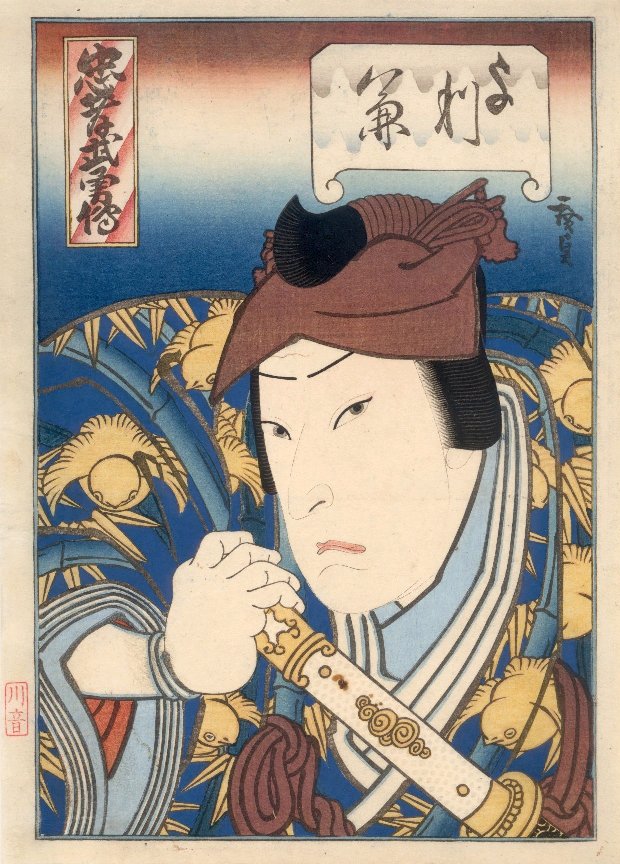 |
||
|
BAMBOO AND SPARROWS |
|||||||
|
竹 |
雀 | ||||||
|
たけ |
すずめ | ||||||
|
|
|
|
|||||
|
Bamboo and sparrow motif on a robe design ca. 1805. |
Bamboo and sparrow motif on the kimono by Toyokuni III ca. 1860 |
Bamboo and sparrow motif by Kunisada ca. 1830 on a hand towel draped over a low screen. |
|||||
|
TAKESUZUME |
|||||||
|
The actor playing the role of Ashikaga Yorikane (足利頼兼) is easily identifiable because his robe is often decorated either with sparrows or bamboo and sparrows combined. The pairing of these two elements is used on the crest (mon - 紋 or もん) of the Date clan. However, this motif does not always guarantee the absolute identification of this figure because we have seen a Kuniyoshi with a beautiful woman standing on a beach and wearing clothing with the same design. Perhaps this is an obtuse allusion to Yorikane, but at this point proving it is beyond our scholarship.
Students of art history are familiar with such iconographic short cuts: a man on a cross is usually Jesus (イエス); a man being barbecued on a grill is St. Lawrence (セントローレンス); a man studiously reading with a docile lion lying nearby is St. Jerome (サンジェローム); a woman standing by a wheel with blade like spikes coming out of it is St. Catherine of Alexandria (セントカサリン.アレグザンドリア) and so on. Similar cues can be found in both sacred and profane Asian art.
John W. Dower in The Elements of Japanese Design (p. 99) states: "Like the lion and peony...the sparrow is commonly depicted with bamboo. The association is a natural one, since flocks of sparrows commonly alight in the bamboo groves..."
Merrily Baird in Symbols of Japan (pp. 118-119) notes that there are early poetic references to sparrows and bamboo. "The bird is said to be obsessed with its honor, especially the repaying of debts.... Nearly three dozen family crests are based on the sparrow." |
|||||||
|
|
忠 孝 武 勇 伝
|
Chūkō means "loyalty and filial piety" |
ち ゅ う こ う |
武 勇 伝
|
ぶ ゆ う で ん |
|||||
|
Series title: Chūkō buyū den |
忠 孝 |
buyū den means "a martial story" |
||||||||
|
|
|
|
|
|
|
|
|
|
PUBLISHER: Kawaoto |
|
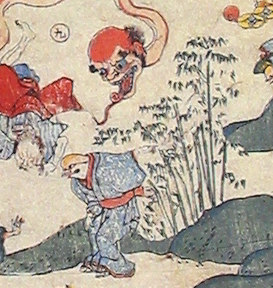 |
||||||
| Above is a detail of a giga print by Kuniyoshi showing an anthropomorphized sparrow pointing at some bamboo nearby. | ||||||
|
Ashikaga Yorikane is the daimyō of Oshu portrayed in the play Date kurabe okuni kabuki (伊達競阿國劇場). |
|
To see another example of a print based on a theme of the kabuki play Date Kurabe Okuni Kabuki click on the patterned motif above. |
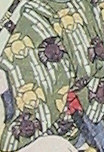

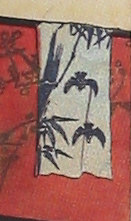

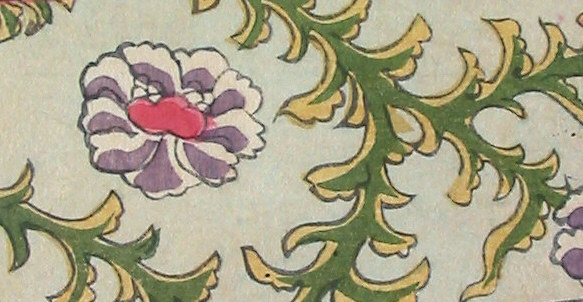
 HOME
HOME